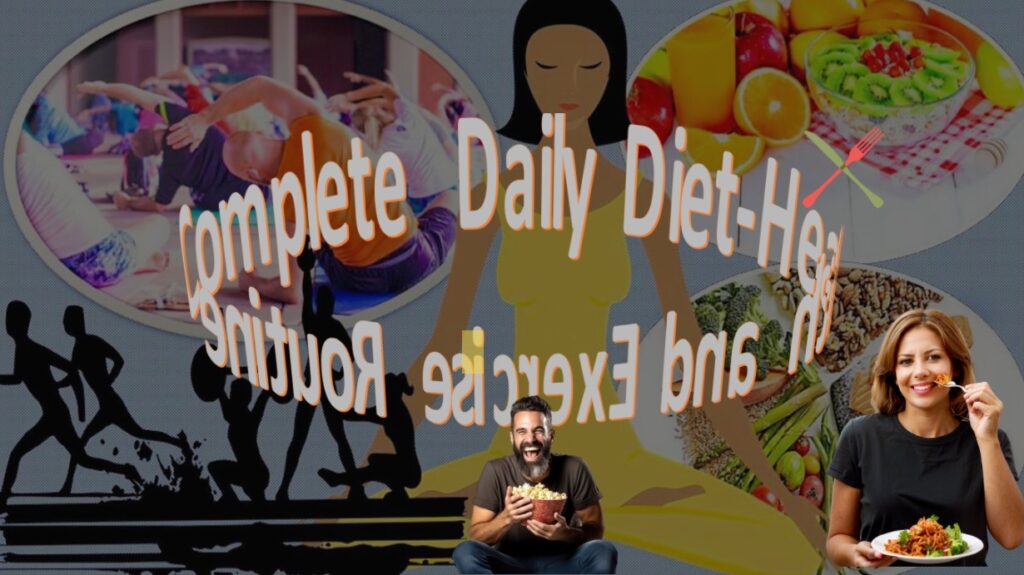Complete Daily Diet & Exercise Routine
A Research Fact-Based info to Nutrition and Activity by Age Group
Note: If you feel unwell, consult a doctor and take care.. A healthy lifestyle depends on consistency what you eat and when you move. Regulated meal and exercise timing optimizes metabolism, diet digestion, and ensures sustained physical and mental energy throughout the day in your body.
1. Early Childhood (Ages 5-10)
This stage requires high energy and nutrients for rapid physical and mental development. Focus on nutrient-dense foods in smaller, frequent portions.
| Meal | Optimal Time | What to Consume & Benefit | Foods to Avoid (Fact Check) |
|---|---|---|---|
| Breakfast | 7:00 AM – 8:00 AM | Whole Eggs: Excellent source of protein and choline (brain development). Oatmeal/Whole Grain Corn: Complex carbohydrates for sustained energy until lunch. | High-Sugar Cereals: Causes rapid fluctuations of energy. Excessive Fruit Juice: High sugar content without the fiber of whole fruit; contributes to tooth decay. |
| Lunch | 12:00 PM – 1:00 PM | Whole Wheat Sandwich/Wrap: Low-fat turkey, cheese, or mashed chickpeas. Carrots/Cucumbers: Provides essential vitamins, minerals, and hydration. | Packaged “Lunchables”: High in sodium, saturated fat, and preservatives. Deep-fried snacks: Provide empty calories and trans fats that harm heart health. |
| Dinner | 6:00 PM – 7:00 PM | Lentils/Beans (Daal): Plant-based protein and fiber for automatic health. Steamed Vegetables (e.g., broccoli): Calcium and Vitamin K for bone strength. | Spicy or Heavy/Greasy Foods: Can cause indigestion and disrupt sleep. |
Activity/Exercise Time
- Goal: Daily 60 minutes of active play.
- Best Time: 4:00 PM – 5:00 PM (before dinner).
- Examples: Running, jumping, cycling, Home play, organized sports.
- Benefit: Develops motor skills, coordination, and strong bones.
Example Tip:
If your child refuses to eat vegetables, grate them finely and make delicious dishes from them, such as meatballs or pasta sauce (for example, grate zucchini into tomato sauce).Benefit: Increases fiber and nutrient intake slightly.
2. Youth (Ages 11-18)
High energy demands due to puberty, growth spurts, and high activity levels. Crucial needs are Calcium (bones) and Iron (especially for menstruating/Maasik girls).
| Meal | Optimal Time | What to Consume & Benefit | Foods to Avoid |
|---|---|---|---|
| Breakfast | 7:00 AM – 7:30 AM | Smoothie: Banana, spinach, whey/plant protein, milk/yogurt. Benefit: Quick, nutrient-dense fuel to support focus in school. | Skipping Breakfast: Leads to low blood sugar, poor concentration, and overeating later in the day. |
| Lunch | 12:30 PM – 1:30 PM | Quinoa/Brown Rice Bowl: Topped with chicken/tofu, black beans, and salsa. Benefit: Complex carbs and protein stabilize energy and support muscle growth. | Excessive Vending Machine Snacks: Typically contain high levels of refined sugar and processed oils, contributing to inflammation. |
| Dinner | 7:30 PM – 8:30 PM | Baked Fish (e.g., Salmon): Omega-3 fatty acids for brain health and mood regulation. Sweet Potatoes: Excellent source of Vitamin A and complex carbohydrates. | Energy Drinks: Contain dangerous amounts of caffeine and sugar, which can interfere with sleep and heart rhythm ($\ge 400 \text{mg}$ caffeine is often the upper safe limit for adults). |
Activity/Exercise Time
- Goal: 60 minutes of moderate-to-vigorous activity daily.
- Best Time: 5:00 PM – 7:00 PM (after school/before dinner).
- Examples: Team sports, running, swimming, light weight training, martial arts.
- Benefit: Improves cardiovascular health, stress management, and builds muscle/bone density.
Example Tip:
Keep a bowl of high-protein snacks like nuts, seeds, and boiled eggs accessible after school. Benefit: Prevents reaching for junk food during the afternoon slump and feeds growing muscles.
3. Adulthood (Ages 20-50)
Focus shifts to weight management, chronic disease prevention, and maintaining muscle mass. Fiber and lean protein are essential.
| Meal | Optimal Time | What to Consume & Benefit | Foods to Avoid |
|---|---|---|---|
| Breakfast | 8:00 AM – 9:00 AM | Greek Yogurt with Berries and Chia Seeds: High protein kickstarts metabolism. Chia seeds provide soluble fiber to help digestion. | Sugary Coffees/Lattes: Calories from simple syrup contribute to weight gain and rapid insulin response. |
| Lunch | 1:00 PM – 2:00 PM | Large Salad with Lean Protein (Tuna, Chickpeas, Chicken Breast): High volume, low-calorie density helps with repletion. Benefit: Fiber from greens supports heart health. | Refined Grains (White Bread/White Rice): They lack fiber and are quickly converted into glucose, leading to an energy slump after lunch. |
| Dinner | 8:00 PM – 9:00 PM | Stir-fry with Tofu/Chicken and 5+ Types of Vegetables: Focus on variety to ensure a wide eating of micronutrients. Rule of Thumb: Dinner should be your lightest meal. | Late-Night Snacking (after 9 PM): Eating close to bedtime interferes with the body’s natural fasting state and sleep quality, promoting fat storage. |
Activity/Exercise Time
- Goal: Mix of cardio and strength training (3-5 days/week).
- Best Time Options:
- Morning (6:30 AM – 7:00 AM): Great for fat burning (often done fasted).
- Evening (5:30 PM – 6:30 PM): Ideal for strength training when muscle temperature is higher.
- Examples: Gym workouts, running, cycling, intense yoga at Home (Vinyasa).
- Benefit: Maintains muscle mass (critical for metabolism) and improves cardiovascular endurance.
Example Tip:
Practice Intermittent Fasting (Time-Restricted Eating): Try to consume all your meals within a 10-12 hour window (e.g., 8:00 AM to 8:00 PM). Benefit: This can improve metabolic health and weight management fits by giving the digestive system a break.
4. Senior Adults (Ages 52-60+)
Nutrient absorption may be reduced and appetite may change. Focus on nutrient-dense, easily digestible foods and ensuring adequate vitamins and vital vitamins.
| Meal | Optimal Time | What to Consume & Benefit | Foods to Avoid |
|---|---|---|---|
| Breakfast | 7:30 AM – 8:30 AM | Fortified Cereal/Oatmeal with Milk: Provides necessary Vitamin and Vital Vitamins. Benefit: Soft and easy to chew/digest. | Very Dry or Hard-to-Chew Foods: This can lead to choking hazards or inadequate feeding due to dental problems. |
| Lunch | 12:00 PM – 1:00 PM | Soup (Chicken/Vegetable broth-based): Excellent for hydration and provides nutrients in an easily consumable form. Benefit: Keeps the digestive system running smoothly. | Excessive Sodium: High salt intake is directly linked to elevated blood pressure, which is a major concern in this age group. |
| Dinner | 7:00 PM – 8:00 PM | Mashed Potatoes/Pumpkin and Minced Lean Meat/Soft Fish: Focus on soft textures and high-quality protein to prevent muscle loss (sarcopenia). | Raw or Undercooked Meats/Eggs: The immune system weakens with age, increasing the risk of foodborne illness. |
Activity/Exercise Time
- Goal: Daily gentle, low-impact movement.
- Best Time: 9:00 AM – 10:00 AM (after breakfast) or 4:00 PM – 5:00 PM (to avoid heat/cold).
- Examples: Walking, Tai Chi, water exercises, gentle Hatha yoga, balance exercises.
- Benefit: Improves balance, prevents falls, maintains joint flexibility, and supports cardiovascular health without undue stress.
Example Tip:
Use protein powder (unflavored) mixed into rolled oats, soups, or even water. Benefit: Ensures adequate protein eating without requiring large food portions, which can be difficult to manage with a reduced appetite.
5. General Tips for Health and Fitness
- Hydration is Key: Drink water consistently throughout the day. Dehydration often mimic’s hunger. Aim for 8 glasses of water daily.
- The 2-Hour Rule (for Dinner): Aim to finish your dinner at least 2-3 hours before you go to bed. This allows the stomach to empty, optimizing digestion and improving sleep quality.
- Mindful Eating: Avoid distractions (phone, TV) while eating. Focus on the taste and texture of your food; this improves satiation and prevents overeating.
- Meal Prepping: Dedicate a small amount of time (e.g., 1 hour on Sunday) to prepare healthy components like chopped veggies, cooked rice, or boiled beans. This makes healthy choices easier during the busy week.
- Listen to Your Body: Calorie needs and activity demands depend on individual factors. Don’t just rely on general calculations; also consider hunger, satiety, and energy levels.

